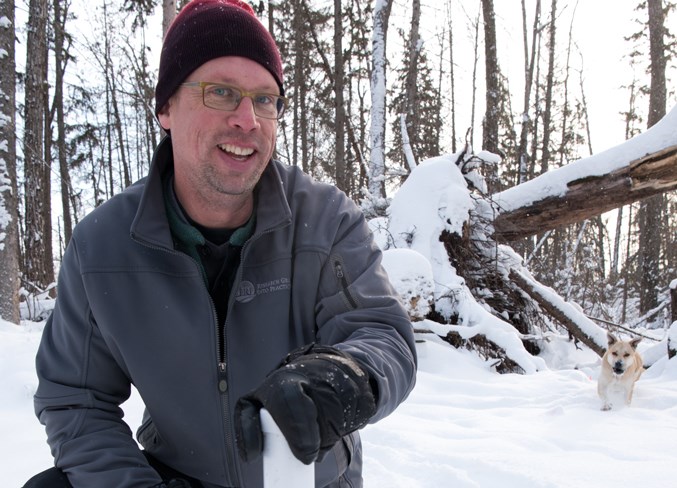A University of Alberta team is working this winter to find out what’s killing the White Spruce Forest.
U of A forestry student Riccardo Baldini and his supervisor, Prof. Axel Anderson, are studying the Grey Nuns White Spruce Park this winter to see if land-use changes are killing off the park’s white spruce trees.
The White Spruce Forest is the oldest tree stand in St. Albert and dates back to at least 1860. Researchers with the Grey Nuns White Spruce Park advisory group have for several years now planted thousands of trees in the forest in an attempt to rejuvenate it.
The forest has seen an unusual number of trees topple over due to the wind in recent years, said advisory group member and retired forestry professor Peter Murphy. He suspects land-use changes, particularly the construction of a natural gas pipeline through the forest around 1969, may be to blame.
Old age is likely a factor in these tree deaths, but Anderson noted not all the old trees are dying – the ones that are have shown up in wet areas.
White spruce trees are sensitive to moisture and have a wide, shallow root system, explained Anderson. If you disrupt groundwater flow in a forest – say, by building a road through it – you can raise the water table, drown roots and kill trees. You’ll find many roads up north where one side of the road will have healthy trees and the other side dead ones as a result.
“As you can see, there’s pretty significant change happening upstream and downstream of this area,” Anderson said, indicating the construction happening around the white spruce forest, all of which could be affecting groundwater flows.
Baldini (who was not available for an interview) is deploying about 20 monitoring tubes so he can map changes in groundwater levels in the forest, Anderson said. The tubes are thin, white and stick about a meter out of the ground. Baldini is also going to measure tree rings in living and dead trees in the forest to judge growth rates and use GPS trackers and laser-radar maps to figure out topography.
Water levels in this forest must have been favourable to spruce for most of the last century as the forest has survived for that long, Anderson said. If the tubes show the water table is now too high for spruce, and the tree rings suggest growth slumps happened around the same time as land-use changes that could affect water levels (such as the gas pipeline), Baldini will have evidence high water levels caused by land-use changes are behind the dying trees.
If the U of A confirms there’s a water table issue, the advisory group hopes it can resolve it by digging strategically placed trenches, Murphy said. The tree rings could also help researchers determine if climate change is involved. Baldini’s research will clarify the region’s hydrology and topography, both of which St. Albert needs to understand before it starts building permanent trails in the forest.
While Anderson said water table issues may also be killing off the forest’s young saplings, Murphy said hungry rabbits and competition from weeds appear to be bigger factors. The advisory committee plans to deploy anti-weed landscape mats and biodegradable tree cages to protect saplings next spring.
Anderson said Baldini would put out the last of his monitoring tubes this week and spend about two years studying the forest. He asked residents not to disturb the tubes.
Murphy said this project would help give U of A students real-life experience and protect the health of young and old trees.
“The forest has been there for hundreds of years and we want to sustain it.”




